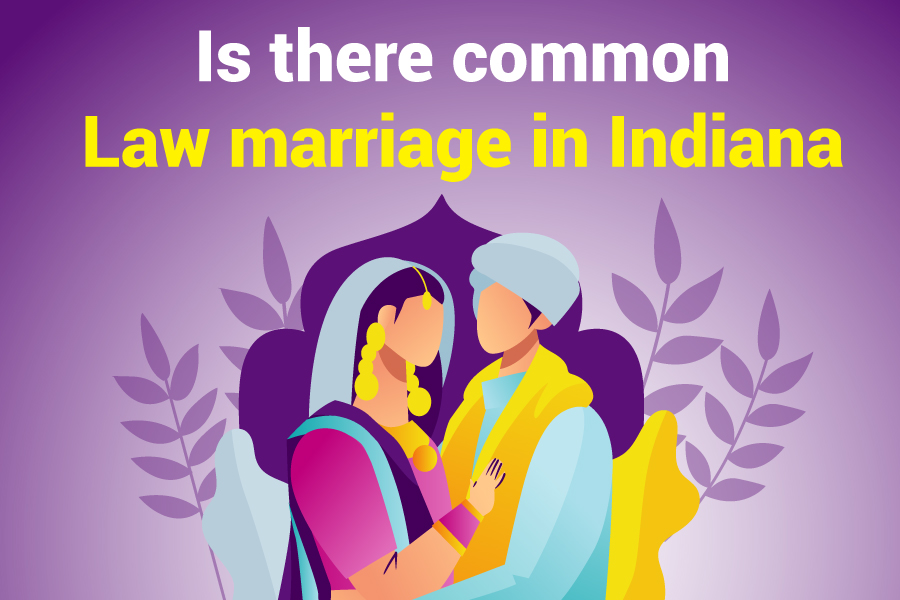In Indiana, the question of whether common law marriage exists adds layers of complexity to the legal rights and obligations of unmarried couples. While the concept of common law marriage has historical significance, its interpretation and recognition in Indiana’s legal system are subject to various factors, including state statutes, court decisions, and evolving societal norms.
Delving into the intricacies of common law marriage in Indiana involves exploring its historical context, legal precedents, and practical implications for couples navigating issues such as property ownership, inheritance rights, and dissolution of relationships. This introduction aims to provide a foundation for a deeper exploration of common law marriage in Indiana, shedding light on its relevance in contemporary society and the challenges it poses within the state’s legal framework.
Is There Common Law Marriage In Indiana?
Yes, Indiana recognizes common-law marriage under certain conditions. To establish a common law marriage in Indiana, couples must demonstrate their intent to be married, cohabitation, and hold themselves out as married. While common law marriage is recognized in Indiana, it’s essential to understand the specific requirements and implications, as they may vary from traditional marriage laws. Consulting with a legal expert can provide clarity on common-law marriage rights and responsibilities in Indiana.
The Historical Context Of Common Law Marriage
Common law marriage has its roots in ancient customs and legal traditions that predate formalized marriage ceremonies. In Indiana, as in other jurisdictions, the historical context of common law marriage provides valuable insights into its evolution and significance within the legal framework of the state.
English Common Law Origins: The concept of common law marriage traces back to English common law principles, which recognized informal unions between couples who lived together and held themselves out as married, even in the absence of a formal marriage ceremony. In medieval England, where literacy rates were low, and clergy were scarce, common law marriage provided a practical solution for couples seeking to establish legal relationships without the need for official documentation.
Colonial America: Common law marriage was prevalent in colonial America, where religious and civil authorities often lacked the resources to perform formal marriage ceremonies. In the absence of legal requirements for marriage registration, couples could establish common law marriages through mutual consent, cohabitation, and public acknowledgment of their relationship as marital.
Legal Recognition In Indiana: Indiana’s legal system inherited the common law tradition from England, including the recognition of common law marriage. In the early days of statehood, Indiana courts upheld the validity of common law marriages, recognizing them as legally binding unions with the same rights and obligations as formal marriages.
Evolution Of Marriage Laws: Over time, as states enacted laws regulating marriage and family relationships, the legal status of common law marriage became subject to statutory interpretation and judicial scrutiny. While some states continued to recognize common law marriage, others enacted statutes requiring formal marriage ceremonies and registration to establish legal marital status.
Modern Interpretations: In modern times, common law marriage remains a controversial and often misunderstood legal concept. While some states have abolished common-law marriage entirely, others, including Indiana, continue to recognize it under certain conditions. Courts in Indiana have upheld common law marriages when couples can demonstrate mutual consent, cohabitation, and holding themselves out as married to others.
Continued Relevance: Despite changes in societal norms and legal requirements, common-law marriage retains its relevance for many couples in Indiana. For those who choose not to formalize their relationships through marriage ceremonies, common law marriage offers a means of establishing legal recognition and rights without the need for official documentation.
Legal Recognition Of Common Law Marriage In Indiana
In Indiana, common law marriage is recognized under certain conditions despite the absence of specific statutory provisions governing its establishment. Understanding the legal recognition of common-law marriage in Indiana requires examining relevant court decisions, statutory interpretations, and legal principles.
- Judicial Precedent: Indiana courts have historically recognized common-law marriage based on principles of equity, fairness, and judicial precedent. While there is no statutory framework for common-law marriage in Indiana, courts have relied on case law to determine the validity of common-law marriages and the rights and obligations of the parties involved.
- Requirements For Common Law Marriage: To establish a common law marriage in Indiana, couples must meet certain criteria, typically including mutual consent to be married, cohabitation, and holding themselves out as married to others. While the specific requirements may vary depending on the circumstances of each case, demonstrating the intent to enter into a marital relationship and behaving as a married couple are essential elements for establishing common law marriage in Indiana.
- Burden Of Proof: In common law marriage cases, the burden of proof rests with the party asserting the existence of the marriage. This means that couples seeking to establish a common law marriage must provide evidence demonstrating their mutual intent to be married, the duration and nature of their cohabitation, and their public acknowledgment of their marital status.
- Factors Considered By Courts: Indiana courts consider various factors when determining the validity of a common-law marriage, including the parties’ conduct, statements, and representations regarding their marital status. Courts may also examine the length of the cohabitation, the parties’ financial arrangements, and their social interactions within the community to assess the nature of their relationship.
- Presumption Of Marriage: In some cases, Indiana courts may presume the existence of a common law marriage based on the parties’ conduct and the surrounding circumstances. This presumption may arise when couples have cohabited for a significant period, presented themselves as married to family, friends, or the community, and engaged in behaviors typically associated with marital relationships.
Requirements For Establishing Common Law Marriage In Indiana
Establishing a common law marriage in Indiana entails meeting specific criteria outlined by state courts and legal principles. While Indiana does not have statutory provisions governing common-law marriage, the state recognizes such unions based on judicial precedent and equitable considerations. Understanding the requirements for establishing a common law marriage in Indiana is crucial for unmarried couples seeking legal recognition and protection of their relationship.
Mutual Consent To Marry:
The foundational requirement for establishing a common law marriage in Indiana is mutual consent between the parties to enter into a marital relationship. Both individuals must agree to be married and intend to assume the rights and responsibilities associated with marriage. This mutual agreement distinguishes common law marriage from mere cohabitation or a casual romantic relationship.
Cohabitation:
Cohabitation is another essential element for establishing a common-law marriage in Indiana. The couple must live together in a shared residence, presenting themselves to the community as a married couple. Cohabitation serves as evidence of the couple’s commitment to their relationship and their intent to function as spouses in a marital union. However, the duration of cohabitation alone may not be sufficient to establish a common-law marriage; other factors must also be considered.
Hold Themselves Out As Married:
In addition to mutual consent and cohabitation, couples seeking to establish a common law marriage in Indiana must hold themselves out as married to others. This may involve referring to each other as spouses, wearing wedding rings, filing joint tax returns, or presenting themselves as married in social or professional settings. Holding themselves out as married demonstrates the couple’s intent to be viewed and treated as spouses by the broader community.
Intent To Establish A Legal Marital Relationship:
Ultimately, the key requirement for establishing a common law marriage in Indiana is the couple’s intent to create a legal marital relationship. This intent must be genuine and demonstrated through their actions, behaviors, and representations to others. Courts will examine the totality of the circumstances to determine whether the couple intended to be legally bound in marriage, considering factors such as their conduct, statements, and interactions with third parties.
Clear And Convincing Evidence:
To establish a common law marriage in Indiana, couples must provide clear and convincing evidence of their intent to be married, cohabitation, and holding themselves out as married. This evidence may include witness testimony, documentary evidence, financial records, and other relevant documentation that supports the existence of a common-law marriage. The burden of proof rests with the parties asserting the existence of the marriage, requiring them to present sufficient evidence to convince the court of its validity.
Implications And Considerations For Couples In Indiana
Establishing a common law marriage in Indiana can have significant legal implications and considerations for couples, impacting various aspects of their lives, rights, and obligations. Understanding these implications is essential for unmarried couples considering or currently in a common-law marriage.
- Property And Assets: Common law spouses in Indiana may need to divide property acquired during their relationship upon separation or death, adhering to equitable distribution principles.
- Inheritance Rights: Surviving common law spouses may inherit a portion of their partner’s estate if no will exists, but the extent of inheritance rights can vary based on circumstances.
- Healthcare Decision-Making: Without legal documentation, such as a durable power of attorney for healthcare, common-law spouses may encounter challenges in making medical decisions for each other during emergencies.
- Parental Rights: Establishing parental rights for common-law spouses may require legal action, especially if one partner is not the biological or adoptive parent of the child.
- Taxation And Financial Matters: Common law spouses should understand their tax obligations, financial responsibilities, and potential joint liability for debts incurred during the relationship.
Final Words
Common law marriage in Indiana carries significant legal implications and considerations for couples. While it provides certain rights and protections, such as property division and inheritance rights, it also presents challenges, particularly in healthcare decision-making and interstate recognition. Couples in common law marriages should be proactive in understanding their rights, creating legal documentation where necessary, and seeking legal advice to navigate potential complexities effectively. By addressing these implications thoughtfully, common-law spouses can protect their interests and ensure their relationships are legally recognized and respected within the state of Indiana.
Robert Stewart is a seasoned law blog writer with a passion for translating complex legal concepts into accessible, informative content. With a keen eye for detail and a knack for storytelling, Robert crafts engaging articles that educate and empower readers in the realm of law.
Drawing upon his extensive experience in the legal field, Robert brings a wealth of knowledge to his writing, covering a diverse range of topics including personal injury, family law, criminal defense, and more. His articles combine thorough research with clear, concise language, making them valuable resources for both legal professionals and laypeople alike.


